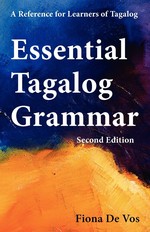Tagalog Ayaw, Gusto, Kaya, Kailangan
The doer is expressed as a Ng phrase (p. 59). The object may be expressed as an Ang phrase (p. 59) (definite) or a Ng phrase (indefinite).
|
Ayaw ni John ang kotse. |
John doesn’t like/want the car. |
|
Gusto ni John ang kotse. |
John likes/wants the car. |
|
Kaya ni John ang trabaho. |
John can do the job. |
|
Kailangan ni John ang trabaho. |
John needs the job. |
|
Ayaw ni John ng kotse. |
John doesn’t want a car. |
|
Gusto ni John ng kotse. |
John wants a car. |
|
Kailangan ni John ng kotse. |
John needs a car. |
Only for ayaw: The object may also be expressed as a Sa phrase (p. 59) (definite).
|
Ayaw ni John sa kotse. |
John doesn’t like the car. |
|
Ayaw ni John sa teacher. |
John doesn’t like the teacher. |
|
Ayaw ni John sa kanya. |
John doesn’t like him/her. |
Note: Ayaw ko is often shortened to ayoko.
Please respect copyright. Learn more
Contents | Detailed Contents | Up ▲
See notes on Terminology and Pronunciation Marks
